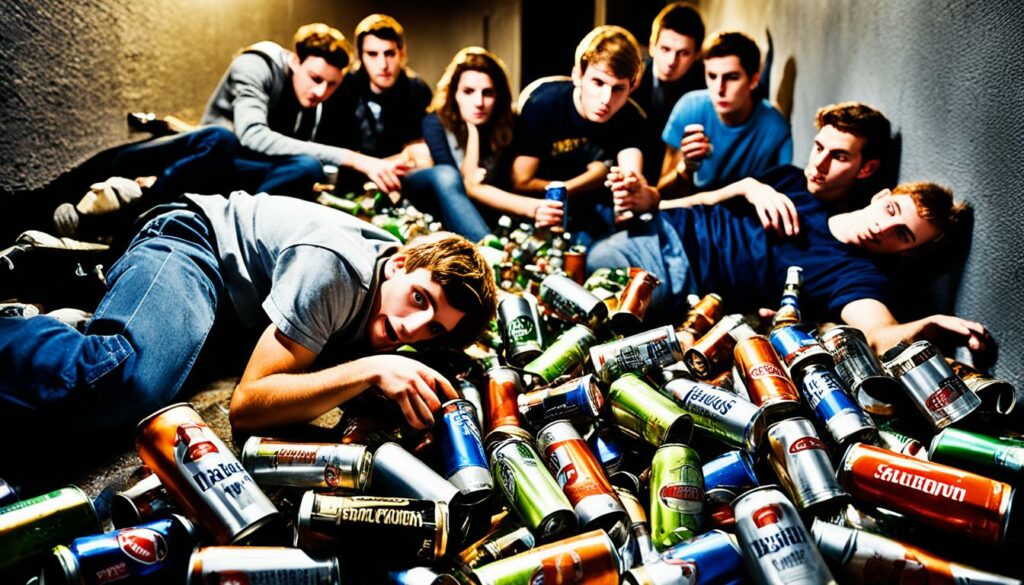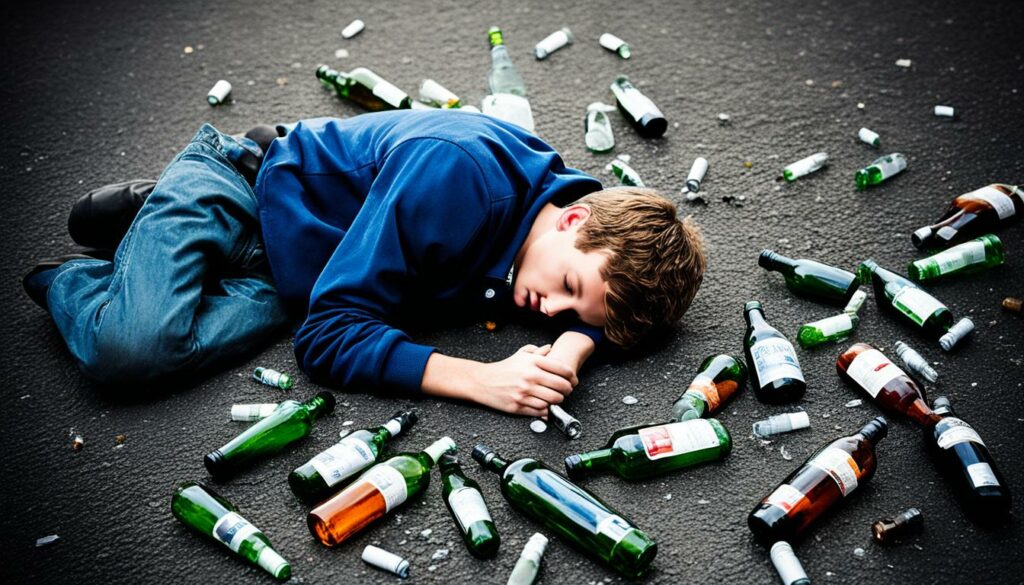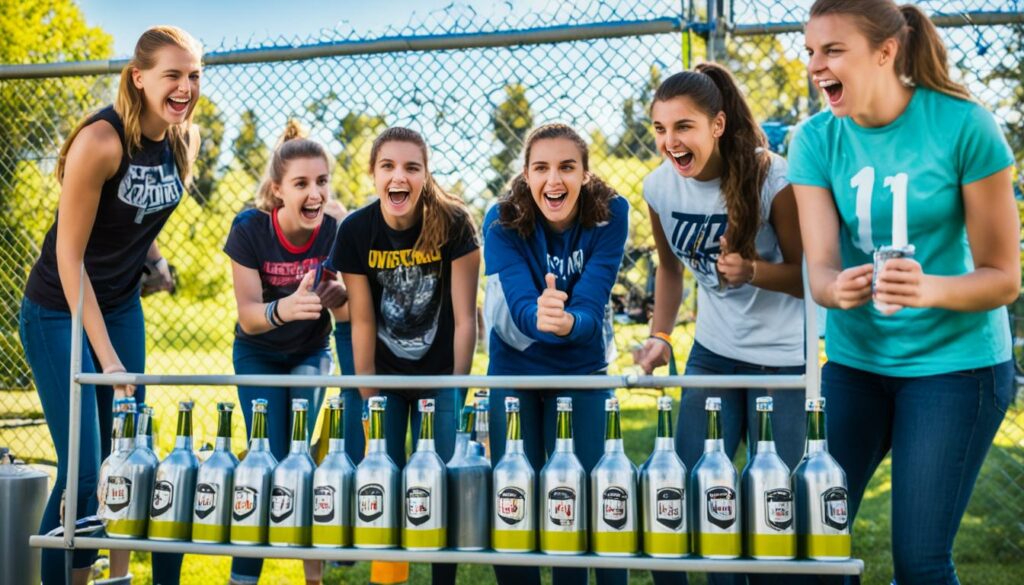Teen Alcohol Consumption: Stats & Insights
Underage drinking is a serious public health problem in the United States, with alcohol being the most widely used substance among America’s youth. According to the National Survey on Drug Use and Health (NSDUH), approximately 19.7% of youth ages 14 to 15 reported having at least one drink in their lifetime. In 2022, 5.9 million youth ages 12 to 20 reported drinking alcohol beyond “just a few sips” in the past month. Adolescent alcohol use differs by race and ethnicity, with White and Hispanic youth being more likely to drink than Black youth. Binge drinking is also a concern among youth, with 3.2 million youth ages 12 to 20 reporting binge drinking at least once in the past month.
Key Takeaways:
- Approximately 5.9 million youth ages 12 to 20 reported drinking alcohol in the past month.
- Race and ethnicity play a role in adolescent alcohol use, with White and Hispanic youth more likely to drink than Black youth.
- 3.2 million youth ages 12 to 20 reported binge drinking at least once in the past month.
Alcohol Consumption by Teens: How Much Is a Drink?

In the United States, a standard drink is defined as any beverage containing 0.6 fluid ounces or 14 grams of pure alcohol. This amount of alcohol can be found in:
- 12 ounces of beer with about 5% alcohol content
- 5 ounces of wine with about 12% alcohol content
- 1.5 ounces of distilled spirits with about 40% alcohol content
It’s important to note that the percentage of pure alcohol may vary within and across beverage types, and serving sizes can differ from standard drink amounts. For example, a large cup of beer or an overpoured glass of wine could contain more alcohol than a standard drink.
Youth Binge Drinking Statistics

When it comes to alcohol consumption among young people, binge drinking stands out as a concerning trend. Binge drinking is defined as consuming a large quantity of alcohol in a short period, typically resulting in a blood alcohol concentration (BAC) of 0.08% or higher.
According to recent statistics, youth ages 12 to 20 account for 3.4% of all alcohol consumed in the United States. Shockingly, more than 90% of all alcoholic beverages consumed by young people are consumed through binge drinking. This pattern of excessive alcohol consumption among the youth poses significant risks and consequences.
In 2022 alone, a staggering 3.2 million youth between the ages of 12 and 20 reported binge drinking at least once in the past month. Additionally, approximately 646,000 young people in the same age group reported engaging in binge drinking on five or more days over the same period.
Binge drinking among youth is not only a health concern but also raises the likelihood of becoming a victim or perpetrator of interpersonal violence. The consequences of binge drinking extend beyond immediate risks, often leading to long-term physical and mental health issues.
“Binge drinking among youth is associated with an increased likelihood of being a victim or perpetrator of interpersonal violence.”
To better understand the implications of youth binge drinking, let’s take a closer look at the data:
| Statistics | Number of Youth (Ages 12-20) |
|---|---|
| Youth who reported binge drinking at least once in the past month | 3.2 million |
| Youth who reported binge drinking on 5 or more days over the past month | 646,000 |
Please refer to the image below for a visual representation of the data:
Drinking Patterns among Teens
Understanding the drinking patterns among teenagers is crucial to address the issue of underage alcohol consumption. Alcohol use often begins during adolescence and becomes more prevalent as teenagers grow older.
Age Differences:
When it comes to alcohol consumption, the numbers vary significantly across different age groups. Among adolescents aged 12 to 13, fewer than 2 in 100 reported drinking alcohol in the past month, and even fewer, fewer than 1 in 100, engaged in binge drinking. However, among respondents aged 16 to 17, the numbers increased, with fewer than 1 in 5 reporting drinking and fewer than 1 in 10 reporting binge drinking. These findings highlight the age-related differences in alcohol use among teenagers.
Gender Differences:
Historically, boys were more likely to engage in alcohol use and binge drinking compared to girls. However, recent trends indicate a shift in these patterns. While alcohol use has declined more among boys in recent years, more girls are reporting alcohol use and binge drinking. This change highlights the importance of considering gender differences in addressing underage drinking and developing targeted prevention strategies.
Comparison of Alcohol Use by Age and Gender
| Alcohol Use | Binge Drinking | |
|---|---|---|
| Ages 12-13 | Fewer than 2 in 100 | Fewer than 1 in 100 |
| Ages 16-17 | Fewer than 1 in 5 | Fewer than 1 in 10 |
Source: https://seowriting.ai/32_6.png
These findings highlight the need to recognize and address the changing drinking patterns among teenagers. By understanding the age and gender differences in alcohol use, we can tailor prevention and intervention programs to effectively reduce underage drinking and its associated risks.
The Dangers of Underage Drinking

Underage drinking carries significant risks and consequences that can have long-lasting impacts on the lives of young individuals. It is crucial to understand the dangers associated with underage drinking to create awareness and promote prevention.
Consequences of Underage Drinking
The consequences of underage drinking extend far beyond the act of consuming alcohol itself. The following are some of the grave risks and negative outcomes associated with underage drinking:
- Motor vehicle crashes: Underage drinking contributes to a significant number of alcohol-related vehicle accidents, leading to injuries and fatalities.
- Homicides: Alcohol use among underage individuals has been linked to violent and aggressive behaviors, increasing the risk of homicides.
- Alcohol overdoses: Unintentional alcohol poisoning can occur among individuals who consume excessive amounts of alcohol, including underage drinkers.
- Falls, burns, and drowning: Impaired judgment and coordination resulting from alcohol consumption can lead to accidents such as falls, burns, and drowning.
- Suicides: Underage drinking can contribute to feelings of depression, impulsivity, and decreased inhibitions, increasing the risk of suicidal ideation and completed suicides.
Risks of Underage Drinking
Engaging in underage drinking exposes young individuals to various risks and adverse effects, including:
- Accidents and injuries: Alcohol impairs cognitive functions and coordination, leading to an increased likelihood of accidents, injuries, and falls.
- Impaired judgment: Consuming alcohol hampers decision-making abilities, making underage drinkers more vulnerable to risky behaviors and dangerous situations.
- Physical and sexual assault: Alcohol use can increase the risk of becoming a victim or perpetrator of physical and sexual assault, leaving a lasting negative impact on an individual’s well-being.
- School and legal problems: Underage drinking can interfere with academic performance and contribute to disciplinary issues both in school and with the law.
- Brain development interference: Starting alcohol consumption at an early age, particularly before the age of 15, can disrupt healthy brain development and potentially lead to long-term cognitive impairments.
Factors Influencing Underage Drinking

There are various reasons why underage drinking occurs, with several factors playing a role in influencing this behavior. These factors include peer pressure, the desire for increased independence, stress, and easy access to alcohol.
Peer pressure: One of the primary reasons for underage drinking is peer pressure. Teenagers often feel the need to fit in and conform to social norms, and this can lead them to engage in drinking activities even if they don’t personally want to.
Desire for increased independence: Many teenagers crave independence and want to be seen as mature and grown-up. Drinking alcohol may be viewed as a way to assert their independence and demonstrate adulthood.
Stress: Teenagers face various stressors in their everyday lives, such as school pressure, family issues, and social challenges. Alcohol can be seen as a coping mechanism to temporarily relieve stress and escape from problems.
Easy access to alcohol: Another significant factor contributing to underage drinking is the easy access to alcohol. Many underage individuals obtain alcohol from within their households, where older adults may unknowingly provide it or leave it easily accessible. In fact, in 2022, approximately 97.7% of adolescents between the ages of 12 and 14 who reported drinking alcohol in the past month obtained it for free.
Prevention strategies should address these factors and focus on changing the way youth think about alcohol. Schools should provide comprehensive education about the risks and consequences of underage drinking, empowering adolescents to make informed decisions. It is crucial for parents to set clear rules against drinking and actively communicate with their children. Communities can play a vital role in mitigating risk factors by providing safe and supervised activities for youth and promoting positive peer influences. Additionally, implementing policies that make alcohol less accessible to underage youth can significantly impact underage drinking rates.
Factors Influencing Underage Drinking
| Factors | Explanation |
|---|---|
| Peer Pressure | Influenced by friends and the desire to fit in |
| Desire for Increased Independence | Viewed as a way to assert adulthood |
| Stress | Used as a coping mechanism and temporary escape |
| Easy Access to Alcohol | Obtained from older adults in households or found at home |
Alcohol Marketing and Underage Drinking
Alcohol marketing plays a significant role in driving underage alcohol consumption. Extensive research has shown that marketing efforts directly influence youth alcohol consumption, leading to an earlier initiation of alcohol use and an increased risk of high-risk drinking behaviors.
Digital alcohol marketing, particularly on social media and the internet, has become increasingly influential among minors. With the widespread use of these platforms, young people are exposed to targeted advertisements and promotions that glamorize alcohol consumption, creating a culture that normalizes and promotes underage drinking.
The profit interests of the alcohol industry are closely linked to underage alcohol consumption. Shockingly, a significant portion of the industry’s sales revenue comes from alcohol sold to underage adolescents in the United States. This disturbing reality highlights the need for stricter regulations and enforcement to curb the harmful effects of alcohol marketing on youth.
“Alcohol marketing has become increasingly sophisticated, targeting vulnerable young people through various channels, including social media and online platforms. This deliberate approach to glamorize alcohol consumption contributes to the normalization of underage drinking.”
Influence of Marketing on Youth Alcohol Consumption
Studies have consistently found a strong association between alcohol marketing and youth alcohol consumption. These marketing efforts have a powerful impact on shaping youth attitudes and behaviors towards alcohol. By leveraging persuasive tactics and appealing imagery, alcohol advertisements seductively present alcohol consumption as an essential and enjoyable part of social life.
Through celebrity endorsements, catchy slogans, and creative branding, alcohol marketing campaigns create a desire for the product and influence young people’s drinking preferences. This direct targeting of youth not only increases the likelihood of alcohol experimentation but also fosters a culture that normalizes and encourages early alcohol consumption.
The influence of marketing on youth alcohol consumption also extends to high-risk drinking behaviors such as binge drinking. Studies have identified a positive correlation between exposure to alcohol advertising and an increased likelihood of engaging in binge drinking among adolescents.
The Role of Regulation in Protecting Youth
Effective regulation is crucial in preventing the harmful impact of alcohol marketing on underage drinking. Governments and regulatory bodies must introduce comprehensive policies that restrict and monitor alcohol advertising practices, particularly those targeted at minors.
Moreover, stricter enforcement of existing regulations is necessary to hold companies accountable for any violation of advertising standards or policies. This includes monitoring digital platforms and social media, where alcohol companies often employ subtle and indirect marketing techniques to reach young audiences.
By implementing robust regulations and enforcement measures, society can safeguard its young population from the influence of alcohol marketing, fostering a healthier and alcohol-free environment for adolescents.
| Impact of Alcohol Marketing on Youth Alcohol Consumption | Statistics |
|---|---|
| Increase in youth alcohol consumption due to marketing influence | 84% |
| Early initiation to alcohol use | 68% |
| Increase in high-risk drinking behaviors | 94% |
| Prevalence of social media and internet as influential marketing channels | 78% |
| Percentage of alcohol industry sales revenue from underage adolescents | 32% |
The Role of Parents in Preventing Underage Drinking
Parents and teachers have a vital role in shaping the attitudes of young people towards alcohol and preventing underage drinking. By actively engaging with their children, parents can have a significant influence on their decisions regarding alcohol consumption.
It is crucial for parents to have open and honest conversations with their children about the dangers and consequences of drinking. By discussing the negative impacts of alcohol in an empathetic and non-judgmental manner, parents can help their children develop a better understanding of the risks involved.
One effective way parents can promote responsible behavior is by modeling it themselves. When parents demonstrate responsible drinking habits and behaviors, their children are more likely to follow suit.
In addition, parents should establish clear rules and expectations regarding alcohol use. By setting and enforcing age-appropriate boundaries, parents can create a safe and supportive environment that discourages underage drinking.
- Get to know your children’s friends: Being familiar with your child’s social circle allows you to have a better understanding of their influences and provide guidance when necessary.
- Have regular conversations: Regularly checking in with your child about their experiences, challenges, and goals can help foster a strong and trusting relationship, making them more likely to seek your guidance in difficult situations.
- Connect with other parents: Building relationships with other parents can provide a network of support and help ensure that expectations and consequences for underage drinking are consistent across social circles.
- Supervise parties and social gatherings: Hosting or supervising events where alcohol may be accessible allows parents to monitor and regulate the presence and consumption of alcohol among youths.
- Encourage alternative activities: Encouraging children to participate in extracurricular activities, hobbies, and sports that do not involve alcohol can help occupy their time and provide a healthier alternative to drinking.
It’s important for parents to be aware of the impact their own attitudes and actions can have on their children’s perceptions of alcohol. Providing alcohol to underage children or displaying positive attitudes towards drinking can inadvertently increase the risk of underage alcohol misuse.
By actively engaging in their child’s life, having open conversations, setting clear boundaries, and promoting healthy alternatives, parents can play a crucial role in preventing underage drinking and creating a positive and supportive environment for their children.
Conclusion
Underage drinking is a significant public health concern in the United States, with many youth engaging in alcohol consumption and binge drinking. It is crucial to implement comprehensive prevention strategies that address individual, school-based, family-based, community-based, and policy-level interventions.
Parents and teachers play a vital role in preventing underage drinking by educating youth about the dangers of drinking, setting clear rules, and being positive role models. They can also supervise activities and guide children towards healthy alternatives to alcohol. By addressing the various factors influencing underage drinking and advocating for stronger enforcement of age limit laws and marketing regulations, we can work towards reducing underage alcohol use and its associated harms.
Preventing underage drinking requires a collaborative effort of parents, educators, communities, and policymakers. It is essential to provide comprehensive education about the risks of alcohol consumption, promote responsible behaviors, and create an environment that discourages underage drinking. By investing in prevention initiatives and continuously monitoring and updating prevention programs, we can safeguard the health and well-being of our youth and create a safer future for generations to come.
FAQ
How many teenagers drink alcohol?
According to the National Survey on Drug Use and Health (NSDUH), approximately 19.7% of youth ages 14 to 15 reported having at least one drink in their lifetime. In 2022, 5.9 million youth ages 12 to 20 reported drinking alcohol beyond “just a few sips” in the past month.
What is the alcohol content in different beverages?
In the United States, a standard drink is defined as any beverage containing 0.6 fluid ounces or 14 grams of pure alcohol. This amount of alcohol can be found in 12 ounces of beer with about 5% alcohol content, 5 ounces of wine with about 12% alcohol content, or 1.5 ounces of distilled spirits with about 40% alcohol content.
What are the consequences of binge drinking among youth?
Binge drinking among youth is associated with an increased likelihood of being a victim or perpetrator of interpersonal violence. It can also lead to accidents and injuries, impair judgment, increase the risk of physical and sexual assault, and cause problems in school or with the law.
How do drinking patterns among teens differ by age and gender?
Historically, adolescent boys were more likely to drink and binge drink than girls. However, in recent years, alcohol use has declined more among boys than girls, with more girls reporting alcohol use and binge drinking.
What are the risks of underage drinking?
Underage drinking can lead to various negative consequences, including an increased risk of accidents and injuries, impaired brain development, higher likelihood of developing alcohol use disorder later in life, and increased risk of physical and sexual assault.
What factors contribute to underage drinking?
Many factors contribute to underage drinking, including peer pressure, increased independence or the desire for it, stress, and easy access to alcohol from older adults in the household or finding it at home.
How does alcohol marketing affect underage drinking?
Alcohol marketing by the industry is a significant driver of underage alcohol use. Research shows that marketing causes youth alcohol consumption, earlier initiation to alcohol use, and high-risk alcohol use. Digital alcohol marketing, particularly on social media and the internet, has become increasingly influential among minors.
What role do parents play in preventing underage drinking?
Parents play a crucial role in shaping youth’s attitudes toward drinking. They can educate their children about the dangers of drinking, set clear rules against drinking, be positive role models, supervise activities, and encourage participation in healthy alcohol-free activities.
How can underage drinking be prevented?
Preventing underage drinking requires a comprehensive approach that considers individual, school-based, family-based, community-based, and policy-level interventions. By addressing the various factors influencing underage drinking, implementing effective prevention strategies, and advocating for stronger enforcement of age limit laws and marketing regulations, we can work towards reducing underage alcohol use and its associated harms.







